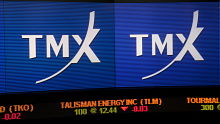
TMX Group Ltd. (TSX:X) is planning to cut the trading fees charged, and rebates paid, under its “maker-taker” fee model, in a bid to address industry complaints and regulatory concerns.
The exchange operator said Monday it is planning a fee/rebate reduction for the Toronto Stock Exchange (TSX), TSX Venture Exchange (TSXV) and TSX Alpha Exchange starting on June 1. TMX is also pledging to implement further reductions every six to nine months or so until, it believes, that the model has reached an optimal level.
Maker-taker fee models — which involve trading venues charging fees to traders for taking liquidity, and paying rebates for adding liquidity — were initially introduced in a bid to reward traders that provide liquidity. However, in recent years, certain segments of the industry, and regulators, have become increasingly vocal with their concerns about the impact of maker-taker fee models on market structure, trading costs, and fairness. These models have been criticized for distorting the markets, making trading too costly, fostering fragmentation and needless intermediation, and creating conflicts of interest.
Last year, the Canadian Securities Administrators (CSA) announced plans for a pilot program to study the elimination of the maker-taker model. And, various trading venues in the U.S. have also recently begun proposing market structure changes to deal with some of the negative unintended consequences that are attributed to maker-taker models.
In announcing its planned reductions, the TMX says that “at its current levels” it recognizes that the model “may no longer be advantageous for the market.” It says that the aim of its planned reductions is to reduce these negative side effects and generate savings for traders and investors, without destabilizing trading activity or market quality.
The exchange operator suggests that, while it agrees that it’s time to curb the impact of maker-taker fee models, it cautions that “an aggressive reduction or ban of rebates could negatively impact both the market and investors. Unintended consequences could include increased spreads, rising volatility as proprietary traders shift towards active strategies, and diminished liquidity for all but the most active securities.” Additionally, it warns that major changes for inter-listed securities could reduce the competitiveness of Canadian markets versus the U.S., and lead to an overall loss of liquidity.
The first phase of reductions will result in an estimated 26% reduction of active fees, and a 31% reduction in passive rebates across all participants trading on the TSX, TSXV and Alpha, it says. For example, the fee for taking liquidity will be reduced from 0.35¢ on inter listed equities on the TSX and TSXV to 0.3¢; and, the corresponding rebate for posting passive liquidity will be reduced from 0.31¢ to 0.26¢. The first phase will also include the elimination of volume-based pricing tiers and the Electronic Liquidity Provider (ELP) program on the TSX.
At this point, it’s not clear where the exchange operator will land in further reducing these fees. It says that this “will be an iterative process as the industry and trading activity adapts to each phase.”
“It is vital that we work together to reshape Canada’s markets to best serve the needs of all traders and investors. To achieve an optimal state, the industry must be united in reducing reliance on the maker-taker fee model,” the TMX says, noting that it will be seeking extensive feedback from the industry on both the initial, and subsequent, phases of reductions.
“Our maker-taker fee optimization program is a continuation of our efforts to re-shape Canada’s equities trading environment and make the markets function better,” said Kevan Cowan, president TSX Markets, group head of equities, TMX Group.